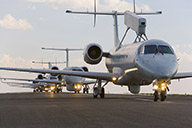During the first quarter of 2018 (1Q18), Embraer delivered 14 jets to the commercial aviation market across the U.S., Europe and Asia Pacific. In the business aviation market, 11 aircraft were delivered in the same period, being eight light jets and three large jets.
See the details below:
Deliveries by Segment
1Q18
Commercial Aviation
14
EMBRAER 175 (E175)
11
EMBRAER 190 (E190)
3
Executive Aviation
11
Phenom 100
3
Phenom 300
5
Light Jets
8
Legacy 450
2
Legacy 500
1
Large Jets
3
TOTAL
25
With respect to the company’s consolidated firm order backlog value in USD, Embraer will be releasing the value of its consolidated 1Q18 backlog together with the 1Q18 earnings results on April 27, 2018, as it is now part of the Financial Statements according to the new IFRS 15 requirements.
The quarter’s main highlight was the triple certification for the E190-E2, the first member of the E-Jets E2 family of commercial aircraft, from the Brazilian Civil Aviation Agency (Agencia Nacional de Aviacao Civil "“ ANAC), the FAA (Federal Aviation Administration) and EASA (European Aviation Safety Agency). It is the first time that an aircraft program with the level of complexity of the E2 receives a type certificate from three major worldwide certification authorities simultaneously.
Before the certification, Embraer announced some final flight tests results confirming the E2 as the most efficient single-aisle aircraft on the market. In fuel consumption, the E190-E2 proved to be 1.3% better than originally expected, a 17.3% improvement compared to the current- generation E190.
The E190-E2 also becomes the most environmentally friendly aircraft in its class, with the lowest levels of external noise and emissions. Flight test results also confirmed the E190-E2 to be better than its original specification in takeoff performance. The aircraft’s range from airports with hot-and-high conditions, such as Denver and Mexico City, increases by 600 nm compared to current-generation aircraft. Its range from airports with short runways, such as London City, also increases by more than 1,000 nm allowing the aircraft to reach destinations like Moscow and cities in the north of Africa.
The E190-E2 will also have the longest maintenance intervals among single-aisle aircraft with 10,000 flight hours for basic checks and no calendar limit for typical utilization. This means an additional 15 days of aircraft utilization over ten years compared to current generation E-Jets. Another key gain is with pilot transition training time. Pilots of current-generation E-Jets will need only 2.5 days of training and no full flight simulator to be qualified to fly an E2…



